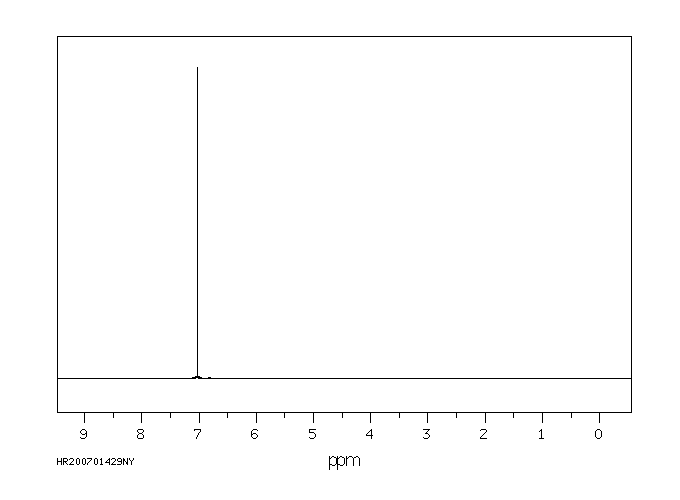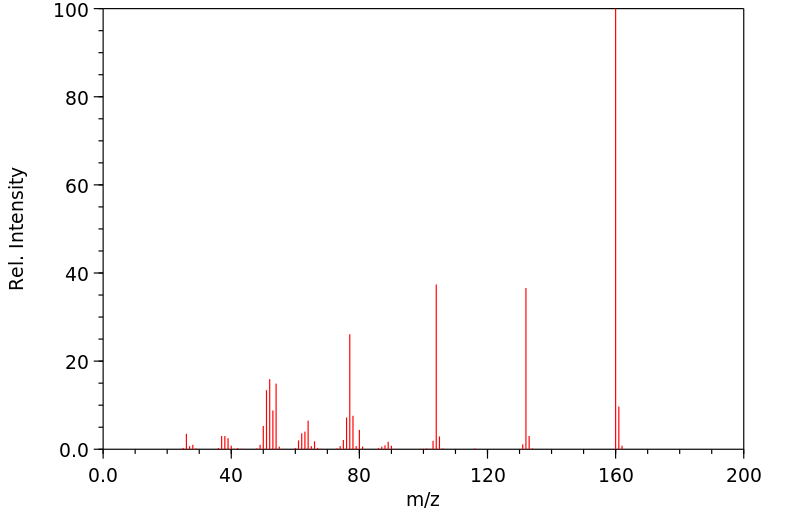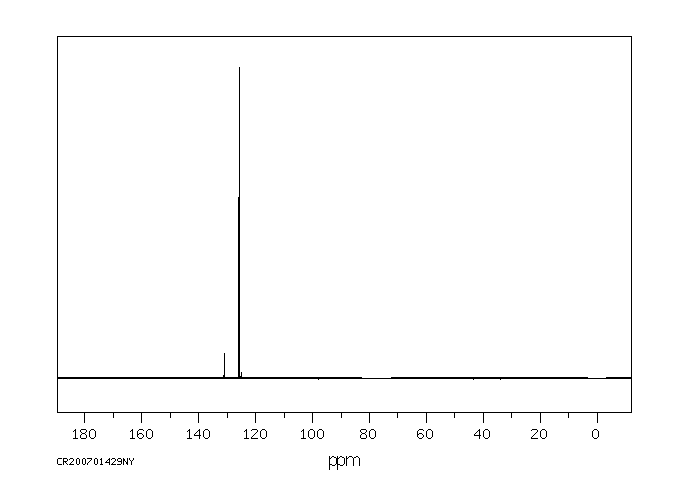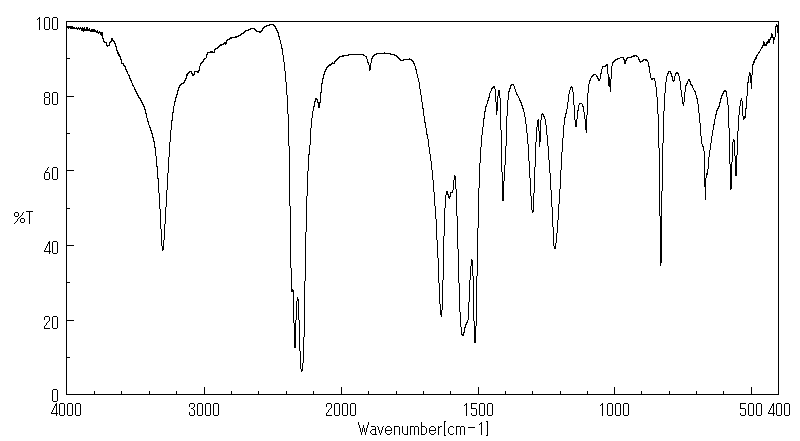对苯二异氰酸酯 | 104-49-4
中文名称
对苯二异氰酸酯
中文别名
1,4-苯二异氰酸酯;对亚苯基二异氰酸酯;1,4-苯二异氰酸;对苯二异酸酯(PPDI);1-丙基哌嗪二氢溴酸;(+)-2-(2-氟-4-联苯基)-丙酸;1,4-二异氰酸苯酯;1,4-亚苯基异氰酸酯;PPDI
英文名称
1,4-diisocyanatobenzene
英文别名
1,4-Phenylene diisocyanate;p-phenylenediisocyanate;PPDI
CAS
104-49-4
化学式
C8H4N2O2
mdl
MFCD00002025
分子量
160.132
InChiKey
ALQLPWJFHRMHIU-UHFFFAOYSA-N
BEILSTEIN
——
EINECS
——
-
物化性质
-
计算性质
-
ADMET
-
安全信息
-
SDS
-
制备方法与用途
-
上下游信息
-
文献信息
-
表征谱图
-
同类化合物
-
相关功能分类
-
相关结构分类
物化性质
-
熔点:96-99 °C (lit.)
-
沸点:260 °C (lit.)
-
密度:1.3848 (rough estimate)
-
闪点:>230 °F
-
溶解度:可溶于THF
-
LogP:3.19 at 20℃
-
物理描述:1,4-phenylene diisocyanate appears as white crystals or pale yellow chunky solid. Pungent odor. (NTP, 1992)
-
蒸汽压力:less than 0.006 mm Hg at 68 °F (NTP, 1992)
-
稳定性/保质期:
Stable and combustible, it is incompatible with strong oxidizing agents, strong alkalis, strong acids, alcohols, and amines. It is also moisture-sensitive.
计算性质
-
辛醇/水分配系数(LogP):3.5
-
重原子数:12
-
可旋转键数:2
-
环数:1.0
-
sp3杂化的碳原子比例:0.0
-
拓扑面积:58.9
-
氢给体数:0
-
氢受体数:4
安全信息
-
危险等级:6.1
-
危险品标志:Xn
-
安全说明:S22,S26,S36/37
-
危险类别码:R42,R20/21/22,R36/37/38
-
WGK Germany:3
-
海关编码:2929109000
-
危险品运输编号:UN 2811 6.1/PG 3
-
RTECS号:CZ6150000
-
储存条件:存储条件为:0-10°C,需置于惰性气体中,并避免接触湿气导致分解和加热。
SDS
SECTION 1: Identification of the substance/mixture and of the company/undertaking
Product identifiers
Product name : 1,4-Phenylene diisocyanate
REACH No. : A registration number is not available for this substance as the substance
or its uses are exempted from registration, the annual tonnage does not
require a registration or the registration is envisaged for a later
registration deadline.
CAS-No. : 104-49-4
Relevant identified uses of the substance or mixture and uses advised against
Identified uses : Laboratory chemicals, Manufacture of substances
SECTION 2: Hazards identification
Classification of the substance or mixture
Classification according to Regulation (EC) No 1272/2008
Acute toxicity, Oral (Category 4), H302
Acute toxicity, Inhalation (Category 4), H332
Acute toxicity, Dermal (Category 4), H312
Skin irritation (Category 2), H315
Serious eye damage (Category 1), H318
Respiratory sensitisation (Category 1), H334
For the full text of the H-Statements mentioned in this Section, see Section 16.
Classification according to EU Directives 67/548/EEC or 1999/45/EC
Xn Harmful R20/21/22, R42
Xi Irritant R38, R41
For the full text of the R-phrases mentioned in this Section, see Section 16.
Label elements
Labelling according Regulation (EC) No 1272/2008
Pictogram
Signal word Danger
Hazard statement(s)
H302 + H312 + H332 Harmful if swallowed, in contact with skin or if inhaled
H315 Causes skin irritation.
H318 Causes serious eye damage.
H334 May cause allergy or asthma symptoms or breathing difficulties if inhaled.
Precautionary statement(s)
P261 Avoid breathing dust.
P280 Wear protective gloves/ eye protection/ face protection.
P305 + P351 + P338 IF IN EYES: Rinse cautiously with water for several minutes. Remove
contact lenses, if present and easy to do. Continue rinsing.
P342 + P311 If experiencing respiratory symptoms: Call a POISON CENTER or doctor/
physician.
Supplemental Hazard none
Statements
Other hazards
Lachrymator.
SECTION 3: Composition/information on ingredients
Substances
Formula : C8H4N2O2
Molecular Weight : 160,13 g/mol
CAS-No. : 104-49-4
EC-No. : 203-207-6
Hazardous ingredients according to Regulation (EC) No 1272/2008
Component Classification Concentration
p-Phenylene diisocyanate
CAS-No. 104-49-4 Acute Tox. 4; Skin Irrit. 2; Eye <= 100 %
EC-No. 203-207-6 Dam. 1; Resp. Sens. 1; H302
+ H312 + H332, H315, H318,
H334
Hazardous ingredients according to Directive 1999/45/EC
Component Classification Concentration
p-Phenylene diisocyanate
CAS-No. 104-49-4 Xn, R20/21/22 - R38 - R41 - <= 100 %
EC-No. 203-207-6 R42
For the full text of the H-Statements and R-Phrases mentioned in this Section, see Section 16
SECTION 4: First aid measures
Description of first aid measures
General advice
Consult a physician. Show this safety data sheet to the doctor in attendance.
If inhaled
If breathed in, move person into fresh air. If not breathing, give artificial respiration. Consult a physician.
In case of skin contact
Wash off with soap and plenty of water. Consult a physician.
In case of eye contact
Rinse thoroughly with plenty of water for at least 15 minutes and consult a physician.
If swallowed
Never give anything by mouth to an unconscious person. Rinse mouth with water. Consult a physician.
Most important symptoms and effects, both acute and delayed
The most important known symptoms and effects are described in the labelling (see section 2.2) and/or in
section 11
Indication of any immediate medical attention and special treatment needed
no data available
SECTION 5: Firefighting measures
Extinguishing media
Suitable extinguishing media
Use water spray, alcohol-resistant foam, dry chemical or carbon dioxide.
Special hazards arising from the substance or mixture
Carbon oxides, nitrogen oxides (NOx)
Advice for firefighters
Wear self contained breathing apparatus for fire fighting if necessary.
Further information
no data available
SECTION 6: Accidental release measures
Personal precautions, protective equipment and emergency procedures
Use personal protective equipment. Avoid dust formation. Avoid breathing vapours, mist or gas. Ensure
adequate ventilation. Evacuate personnel to safe areas. Avoid breathing dust.
For personal protection see section 8.
Environmental precautions
Do not let product enter drains.
Methods and materials for containment and cleaning up
Pick up and arrange disposal without creating dust. Sweep up and shovel. Keep in suitable, closed
containers for disposal.
Reference to other sections
For disposal see section 13.
SECTION 7: Handling and storage
Precautions for safe handling
Avoid contact with skin and eyes. Avoid formation of dust and aerosols.
Provide appropriate exhaust ventilation at places where dust is formed.
For precautions see section 2.2.
Conditions for safe storage, including any incompatibilities
Store in cool place. Keep container tightly closed in a dry and well-ventilated place.
Air and moisture sensitive. Handle and store under inert gas.
Specific end use(s)
A part from the uses mentioned in section 1.2 no other specific uses are stipulated
SECTION 8: Exposure controls/personal protection
Control parameters
Components with workplace control parameters
Exposure controls
Appropriate engineering controls
Handle in accordance with good industrial hygiene and safety practice. Wash hands before breaks and
at the end of workday.
Personal protective equipment
Eye/face protection
Face shield and safety glasses Use equipment for eye protection tested and approved under
appropriate government standards such as NIOSH (US) or EN 166(EU).
Skin protection
Handle with gloves. Gloves must be inspected prior to use. Use proper glove removal technique
(without touching glove's outer surface) to avoid skin contact with this product. Dispose of
contaminated gloves after use in accordance with applicable laws and good laboratory practices.
Wash and dry hands.
The selected protective gloves have to satisfy the specifications of EU Directive 89/686/EEC and
the standard EN 374 derived from it.
Body Protection
Complete suit protecting against chemicals, The type of protective equipment must be selected
according to the concentration and amount of the dangerous substance at the specific workplace.
Respiratory protection
Where risk assessment shows air-purifying respirators are appropriate use a full-face particle
respirator type N100 (US) or type P3 (EN 143) respirator cartridges as a backup to engineering
controls. If the respirator is the sole means of protection, use a full-face supplied air respirator. Use
respirators and components tested and approved under appropriate government standards such
as NIOSH (US) or CEN (EU).
Control of environmental exposure
Do not let product enter drains.
SECTION 9: Physical and chemical properties
Information on basic physical and chemical properties
a) Appearance Form: solid
b) Odour no data available
c) Odour Threshold no data available
d) pH no data available
e) Melting point/freezing Melting point/range: 96 - 99 °C - lit.
point
f) Initial boiling point and 260 °C - lit.
boiling range
g) Flash point > 113 °C - closed cup
h) Evapouration rate no data available
i) Flammability (solid, gas) no data available
j) Upper/lower no data available
flammability or
explosive limits
k) Vapour pressure < 0,01 hPa at 20 °C
l) Vapour density no data available
m) Relative density no data available
n) Water solubility no data available
o) Partition coefficient: n- no data available
octanol/water
p) Auto-ignition no data available
temperature
q) Decomposition no data available
temperature
r) Viscosity no data available
s) Explosive properties no data available
t) Oxidizing properties no data available
Other safety information
no data available
SECTION 10: Stability and reactivity
Reactivity
no data available
Chemical stability
Stable under recommended storage conditions.
Possibility of hazardous reactions
no data available
Conditions to avoid
Air
Incompatible materials
Strong oxidizing agents, Amines, Strong bases, Strong acids
Hazardous decomposition products
Other decomposition products - no data available
In the event of fire: see section 5
SECTION 11: Toxicological information
Information on toxicological effects
Acute toxicity
no data available
Skin corrosion/irritation
Skin - rabbit
Result: Severe skin irritation
Serious eye damage/eye irritation
no data available
Respiratory or skin sensitisation
Germ cell mutagenicity
no data available
Carcinogenicity
IARC: No component of this product present at levels greater than or equal to 0.1% is identified as
probable, possible or confirmed human carcinogen by IARC.
Reproductive toxicity
no data available
Specific target organ toxicity - single exposure
no data available
Specific target organ toxicity - repeated exposure
no data available
Aspiration hazard
no data available
Additional Information
RTECS: CZ6150000
burning sensation, Cough, wheezing, laryngitis, Shortness of breath, spasm, inflammation and edema of
the larynx, spasm, inflammation and edema of the bronchi, pneumonitis, pulmonary edema, Material is
extremely destructive to tissue of the mucous membranes and upper respiratory tract, eyes, and skin.,
Headache, Nausea, Vomiting
SECTION 12: Ecological information
Toxicity
no data available
Persistence and degradability
no data available
Bioaccumulative potential
no data available
Mobility in soil
no data available
Results of PBT and vPvB assessment
PBT/vPvB assessment not available as chemical safety assessment not required/not conducted
Other adverse effects
no data available
SECTION 13: Disposal considerations
Waste treatment methods
Product
Offer surplus and non-recyclable solutions to a licensed disposal company. Dissolve or mix the material
with a combustible solvent and burn in a chemical incinerator equipped with an afterburner and scrubber.
Contaminated packaging
Dispose of as unused product.
SECTION 14: Transport information
UN number
ADR/RID: - IMDG: - IATA: 3335
UN proper shipping name
ADR/RID: Not dangerous goods
IMDG: Not dangerous goods
IATA: Aviation regulated solid, n.o.s.
Transport hazard class(es)
ADR/RID: - IMDG: - IATA: 9
Packaging group
ADR/RID: - IMDG: - IATA: III
Environmental hazards
ADR/RID: no IMDG Marine pollutant: no IATA: no
Special precautions for user
no data available
SECTION 15: Regulatory information
This safety datasheet complies with the requirements of Regulation (EC) No. 1907/2006.
Safety, health and environmental regulations/legislation specific for the substance or mixture
no data available
Chemical Safety Assessment
For this product a chemical safety assessment was not carried out
SECTION 16: Other information
Full text of H-Statements referred to under sections 2 and 3.
Acute Tox. Acute toxicity
Eye Dam. Serious eye damage
H302 Harmful if swallowed.
H302 + H312 + Harmful if swallowed, in contact with skin or if inhaled
H332
H312 Harmful in contact with skin.
H315 Causes skin irritation.
H318 Causes serious eye damage.
H332 Harmful if inhaled.
H334 May cause allergy or asthma symptoms or breathing difficulties if inhaled.
Full text of R-phrases referred to under sections 2 and 3
Xn Harmful
R20/21/22 Harmful by inhalation, in contact with skin and if swallowed.
R38 Irritating to skin.
R41 Risk of serious damage to eyes.
R42 May cause sensitisation by inhalation.
Further information
Copyright 2013 Co. LLC. License granted to make unlimited paper copies for internal use
only.
The above information is believed to be correct but does not purport to be all inclusive and shall be
used only as a guide. The information in this document is based on the present state of our knowledge
and is applicable to the product with regard to appropriate safety precautions. It does not represent any
guarantee of the properties of the product. Corporation and its Affiliates shall not be held
liable for any damage resulting from handling or from contact with the above product. See
and/or the reverse side of invoice or packing slip for additional terms and conditions of sale.
上下游信息
反应信息
-
作为反应物:参考文献:名称:Caraculacu, Adrian A.; Agherghinei, Ion; Gaspar, Mariana, Journal of the Chemical Society. Perkin transactions II, 1990, # 8, p. 1343 - 1348摘要:DOI:
-
作为产物:描述:参考文献:名称:Synthesis of isocyanates from carbamate esters employing boron trichloride摘要:在有 Et3N 存在的情况下,使用 BCl3 可以将氨基甲酸酯转化为具有工业重要性的异氰酸酯和二异氰酸酯;该反应的实施和操作简单,在温和的条件下进行,并能以极高的产率获得异氰酸酯。DOI:10.1039/a807287f
-
作为试剂:参考文献:名称:脂肪酸的新型抗菌杂环类似物的设计与合成摘要:设计了一系列新的长链异恶唑衍生物作为白色念珠菌的细胞色素P450-14DM14a-脱甲基酶的抑制剂和大肠杆菌的S12蛋白的核糖体亚基。新型化合物(6 – 10通过将一氧化氮与长链链烷酸和链烯基/羟基链烯基酯进行1,3-偶极环加成合成,并通过纸片扩散法检测其抗菌活性,并通过肉汤微稀释法检测MIC。在预测化合物的隐藏潜力和药物相似性之后,还计算了与ADMET相关的描述子,以预测药代动力学特性。已经进行了分子对接研究以评估分子在受体活性位点的可能作用方式。化合物(9和10)显示出优异的抗微生物活性,几乎与对照化合物相当。DOI:10.1016/j.ejmech.2013.10.051
文献信息
-
Diamine Compound Having Phosphorylcholine Group, Polymer Thereof, and Process for Producing the Polymer申请人:Nagase Yu公开号:US20100036081A1公开(公告)日:2010-02-11Highly polymerizable diamine compounds having a phosphorylcholine group are disclosed. High-molecular weight polymers are obtained from the highly polymerizable diamine compound having a phosphorylcholine group as a monomer, and the polymers have improved mechanical strength, water resistance and heat resistance while maintaining excellent biocompatibility and processability of MPC polymers. Processes for producing the polymers are disclosed. The diamine compounds having a phosphorylcholine group are represented by Formula (I). The polymers contain at least 1 mol % of a specific structural unit with a phosphorylcholine group represented by Formula (II) and have a number average molecular weight of not less than 5,000. In the processes, the diamine compound is used as a monomer.
-
Bishydroxyureas申请人:3M Innovative Properties Company公开号:US06121323A1公开(公告)日:2000-09-19Bishydroxyureas are provided that inhibit the enzyme 5-lipoxygenase. These compounds have the formula I ##STR1## wherein R.sub.1, R.sub.2, R.sub.3, R.sub.4, A and M are defined herein. Also disclosed are pharmaceutical compositions containing such compounds and methods of inhibiting the enzyme 5-lipoxygenase using such compounds.
-
[EN] AGONISTS OF GPR40<br/>[FR] AGONISTES DE GPR40申请人:CONNEXIOS LIFE SCIENCES PVT LTD公开号:WO2012011125A1公开(公告)日:2012-01-26The present invention relates to compounds that have the ability to modulate the activity of GPR40 and are therefore useful in the treatment of GPR40 related disorders. In addition the invention relates to the compounds, methods for their preparation, pharmaceutical compositions containing the compounds and the uses of these compounds in the treatment of certain disorders related to GPR40 activity.本发明涉及具有调节GPR40活性能力的化合物,因此在治疗与GPR40相关的疾病方面具有用处。此外,该发明涉及这些化合物、其制备方法、含有这些化合物的药物组合物以及在治疗与GPR40活性相关的某些疾病方面使用这些化合物的用途。
-
Rigid and Compact Binuclear Bis‐hydrated Gd‐complexes as High Relaxivity MRI Agents作者:Loredana Leone、Luca Guarnieri、Jonathan Martinelli、Massimo Sisti、Andrea Penoni、Mauro Botta、Lorenzo TeiDOI:10.1002/chem.202101701日期:2021.8.16Gd-complexes. Thus, the 1H relaxometric study on [Gd2PCTA2(H2O)4] and on [Gd2AAZTA2(H2O)4]2− highlighted the remarkable rigidity and compactness of the two binuclear complexes, which results in molar relaxivities (per Gd), at 1.5 T and 298 K of ca. 12–12.6 mM−1 s−1 with an increase of ca. 80 % at 1.5 T and 298 K (+70 % at 310 K) with respect to the corresponding mononuclear complexes.
-
[EN] PROCESS FOR MANUFACTURING ISOCYANATES<br/>[FR] PROCÉDÉ POUR LA FABRICATION D'ISOCYANATES申请人:HUNTSMAN INT LLC公开号:WO2010060773A1公开(公告)日:2010-06-03The present invention relates to a process for manufacturing isocyanates from an amine compound. The process comprises the steps of a) Providing chlorine; b) Providing carbon monoxide; c) Reacting said chlorine and said carbon monoxide for providing phosgene, the carbon monoxide being provided in an adjustable molar excess; d) Providing an amine compound and phosgenating said amine compound using said phosgene thereby providing said isocyanate; the process further comprises adjusting said adjustable molar excess, i.e. the molar excess of carbon monoxide, for adjusting the colour of the isocyanate.
表征谱图
-
氢谱1HNMR
-
质谱MS
-
碳谱13CNMR
-
红外IR
-
拉曼Raman
-
峰位数据
-
峰位匹配
-
表征信息
同类化合物
(βS)-β-氨基-4-(4-羟基苯氧基)-3,5-二碘苯甲丙醇
(S,S)-邻甲苯基-DIPAMP
(S)-(-)-7'-〔4(S)-(苄基)恶唑-2-基]-7-二(3,5-二-叔丁基苯基)膦基-2,2',3,3'-四氢-1,1-螺二氢茚
(S)-盐酸沙丁胺醇
(S)-3-(叔丁基)-4-(2,6-二甲氧基苯基)-2,3-二氢苯并[d][1,3]氧磷杂环戊二烯
(S)-2,2'-双[双(3,5-三氟甲基苯基)膦基]-4,4',6,6'-四甲氧基联苯
(S)-1-[3,5-双(三氟甲基)苯基]-3-[1-(二甲基氨基)-3-甲基丁烷-2-基]硫脲
(R)富马酸托特罗定
(R)-(-)-盐酸尼古地平
(R)-(-)-4,12-双(二苯基膦基)[2.2]对环芳烷(1,5环辛二烯)铑(I)四氟硼酸盐
(R)-(+)-7-双(3,5-二叔丁基苯基)膦基7''-[((6-甲基吡啶-2-基甲基)氨基]-2,2'',3,3''-四氢-1,1''-螺双茚满
(R)-(+)-7-双(3,5-二叔丁基苯基)膦基7''-[(4-叔丁基吡啶-2-基甲基)氨基]-2,2'',3,3''-四氢-1,1''-螺双茚满
(R)-(+)-7-双(3,5-二叔丁基苯基)膦基7''-[(3-甲基吡啶-2-基甲基)氨基]-2,2'',3,3''-四氢-1,1''-螺双茚满
(R)-(+)-4,7-双(3,5-二-叔丁基苯基)膦基-7“-[(吡啶-2-基甲基)氨基]-2,2”,3,3'-四氢1,1'-螺二茚满
(R)-3-(叔丁基)-4-(2,6-二苯氧基苯基)-2,3-二氢苯并[d][1,3]氧杂磷杂环戊烯
(R)-2-[((二苯基膦基)甲基]吡咯烷
(R)-1-[3,5-双(三氟甲基)苯基]-3-[1-(二甲基氨基)-3-甲基丁烷-2-基]硫脲
(N-(4-甲氧基苯基)-N-甲基-3-(1-哌啶基)丙-2-烯酰胺)
(5-溴-2-羟基苯基)-4-氯苯甲酮
(5-溴-2-氯苯基)(4-羟基苯基)甲酮
(5-氧代-3-苯基-2,5-二氢-1,2,3,4-oxatriazol-3-鎓)
(4S,5R)-4-甲基-5-苯基-1,2,3-氧代噻唑烷-2,2-二氧化物-3-羧酸叔丁酯
(4S,4''S)-2,2''-亚环戊基双[4,5-二氢-4-(苯甲基)恶唑]
(4-溴苯基)-[2-氟-4-[6-[甲基(丙-2-烯基)氨基]己氧基]苯基]甲酮
(4-丁氧基苯甲基)三苯基溴化磷
(3aR,8aR)-(-)-4,4,8,8-四(3,5-二甲基苯基)四氢-2,2-二甲基-6-苯基-1,3-二氧戊环[4,5-e]二恶唑磷
(3aR,6aS)-5-氧代六氢环戊基[c]吡咯-2(1H)-羧酸酯
(2Z)-3-[[(4-氯苯基)氨基]-2-氰基丙烯酸乙酯
(2S,3S,5S)-5-(叔丁氧基甲酰氨基)-2-(N-5-噻唑基-甲氧羰基)氨基-1,6-二苯基-3-羟基己烷
(2S,2''S,3S,3''S)-3,3''-二叔丁基-4,4''-双(2,6-二甲氧基苯基)-2,2'',3,3''-四氢-2,2''-联苯并[d][1,3]氧杂磷杂戊环
(2S)-(-)-2-{[[[[3,5-双(氟代甲基)苯基]氨基]硫代甲基]氨基}-N-(二苯基甲基)-N,3,3-三甲基丁酰胺
(2S)-2-[[[[[((1S,2S)-2-氨基环己基]氨基]硫代甲基]氨基]-N-(二苯甲基)-N,3,3-三甲基丁酰胺
(2S)-2-[[[[[[((1R,2R)-2-氨基环己基]氨基]硫代甲基]氨基]-N-(二苯甲基)-N,3,3-三甲基丁酰胺
(2-硝基苯基)磷酸三酰胺
(2,6-二氯苯基)乙酰氯
(2,3-二甲氧基-5-甲基苯基)硼酸
(1S,2S,3S,5S)-5-叠氮基-3-(苯基甲氧基)-2-[(苯基甲氧基)甲基]环戊醇
(1S,2S,3R,5R)-2-(苄氧基)甲基-6-氧杂双环[3.1.0]己-3-醇
(1-(4-氟苯基)环丙基)甲胺盐酸盐
(1-(3-溴苯基)环丁基)甲胺盐酸盐
(1-(2-氯苯基)环丁基)甲胺盐酸盐
(1-(2-氟苯基)环丙基)甲胺盐酸盐
(1-(2,6-二氟苯基)环丙基)甲胺盐酸盐
(-)-去甲基西布曲明
龙蒿油
龙胆酸钠
龙胆酸叔丁酯
龙胆酸
龙胆紫-d6
龙胆紫










